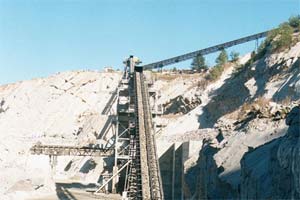The light of quality and civilization shines the world!
 Products Center
Products Center
 Stone Crusher
Stone Crusher
 Grinding Mill
Grinding Mill
 Optional Equipment
Optional Equipment
 Mobile Crusher
Mobile Crusher
 Knowledge Hall
Knowledge Hall
 Crushers FAQ
Crushers FAQ
 Grinding Mills FAQ
Grinding Mills FAQ
 Mining Equipments
Mining Equipments
 Solution
Solution
 Stone Crushing
Stone Crushing
 Sand Making
Sand Making
 Ore Processing
Ore Processing
 Grinding Plant
Grinding Plant
 Construction Building Material
Construction Building Material
Home>Solution>Ore Processing>Uranium mining

Uranium mining Plant
Uranium ores were mainly mined underground or in the open pit in the past. The processes of detecting, mining and separating ores will generate a large amount of waste ores and slags. It is often the case that a ton of uranium ores could produce less than one kilogram of uranium. In addition, protective measures must be taken against the daughter radium and radon, highly toxic radionuclides which are created by uranium decay. China has proposed a seven-word-treatment of waste ores and slags, namely interception, protection, landfill, seal, dredging, cap and planting. The proposal has effectively reduced the precipitation rate of radon in the air and the density of uranium and radium in the water.
Uranium mining process
 The recently developed in-ground leach method is designed to process sandstone-type uranium ores. As the method spares the need to dig the ores out, many processes, including transportation and grinding are saved. With the method, the uranium can be extracted only through digging a few wells and pumping acid (or alkaline) solvent into the ground. And then the uranium pulp could be pumped from the underground and directly transferred to the hydrometallurgical plant for processing. In this way, the mining and separation of uranium ores as well as the metallurgical process are combined together, greatly reducing waste ores and slags that would pollute the environment. In-ground leach is indeed a good method. However, so far this method is not applicable to most of the uranium deposits.
The recently developed in-ground leach method is designed to process sandstone-type uranium ores. As the method spares the need to dig the ores out, many processes, including transportation and grinding are saved. With the method, the uranium can be extracted only through digging a few wells and pumping acid (or alkaline) solvent into the ground. And then the uranium pulp could be pumped from the underground and directly transferred to the hydrometallurgical plant for processing. In this way, the mining and separation of uranium ores as well as the metallurgical process are combined together, greatly reducing waste ores and slags that would pollute the environment. In-ground leach is indeed a good method. However, so far this method is not applicable to most of the uranium deposits.
Apart from in-ground leach, there are heap leach, in-situ blast leach and bacterial leach. In the heap leach method, uranium ores that have been crushed will be heaped up in a pile, then dilute sulfuric acid will be sprayed on the pile to collect the leaching solution. In the in-situ blast leach method, the ores of the mining field will be crushed into certain blocks and sprayed with solution that have been prepared. Then the leach solution will be transferred to the metallurgical plant for processing. The bacterial leach is a method which leaches uranium from ores with a few or without sulfuric acid through bacterial oxidation. The most commonly used bacteria in the method are those who could oxidize iron sulfide minerals, including thiobacillus thiooxidans and thiobacillus ferrooxidant. So far, the bacterial leach method has not been applied in industries.
Uranium refining
Uranium pulp could be extracted from the uranium ores after being leached in acid (like sulfuric acid) or alkaline (like sodium carbonate). The pulp, through chemical extraction, ion exchange and sedimentation, could be processed into coarse products called "yellow cake". The "yellow cake" have many impurities, many of which are toxins that "eat" neutrons, particles that maintain the chain reaction. Therefore, the coarse products need further purification and refining. And the process is called the refining of uranium.
The refining methods include solvent extraction, ion exchange, combination of ion-exchange and solvent extraction, and sedimentation. A intermediate product of uranium could be obtained after the refining process. And the intermediate product needs to undergo chemical conversion to get uranium dioxide and uranium metal which could serve as fuel for heavy-water reactor in the next phase. After being enriched by uranium-235, the uranium dioxide and uranium metal will become fuel for light-water reactor and research reactor or serve as loading of atomic bombs.
